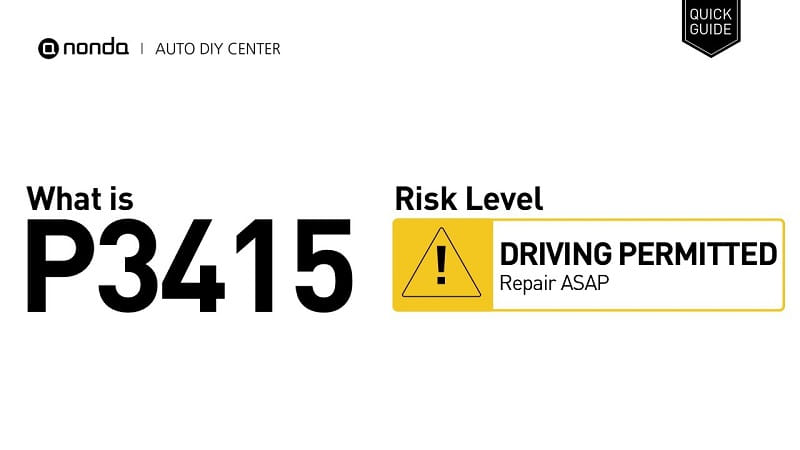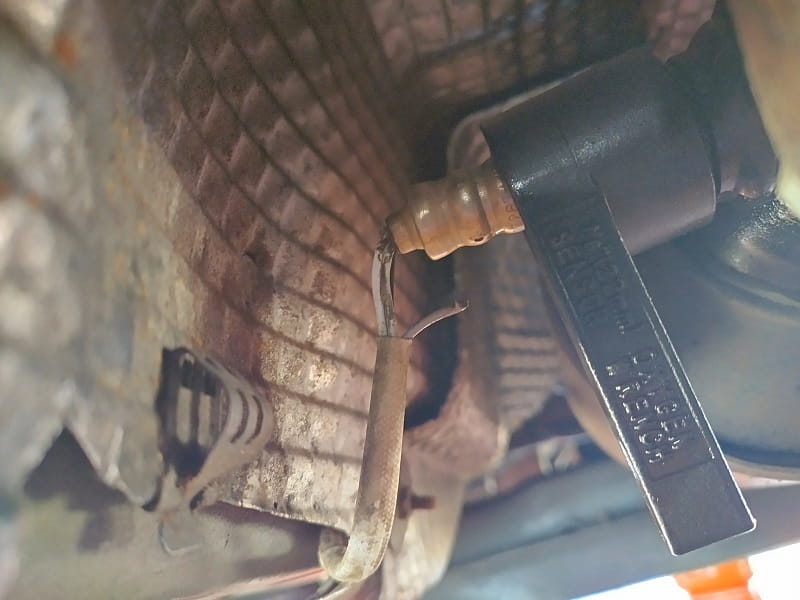This post contains affiliate links. This means I will make a commission at no extra cost to you should you click through and make a purchase [ “As an Amazon Associate, I earn from qualifying purchases.” ]. Read the full disclosure here.
Understanding Diagnostic Trouble Code P3415 Cylinder 2 Exhaust Valve Control Circuit Low GuideMechanic.Com With the increasing complexity of modern engines, vehicles now come equipped with advanced systems to improve fuel efficiency, emissions, and overall performance.
Among the most vital of these systems is the Variable Valve Timing (VVT) and cylinder deactivation system, which adjusts valve timing and engine output based on driving conditions.
These systems are governed by various sensors, actuators, and solenoids monitored by the vehicle’s Powertrain Control Module (PCM).
When one of these systems malfunctions, the PCM logs a Diagnostic Trouble Code (DTC) to alert technicians to a specific issue.
One such code is P3415 – Cylinder 2 Exhaust Valve Control Circuit Low. This article explores what this code means, its symptoms, possible causes, diagnosis procedures, and repair options to resolve the issue effectively.
See Also: P3416 Cylinder 2 Exhaust Valve Control Circuit High
P3415 Cylinder 2 Exhaust Valve Control Circuit Low
What Does Code P3415 Mean?

DTC P3415 stands for “Cylinder 2 Exhaust Valve Control Circuit Low.” This code is set when the PCM detects a lower-than-expected voltage in the electrical control circuit that manages the exhaust valve actuator for cylinder 2.
In simpler terms, this code indicates an electrical issue—the control module is attempting to activate the exhaust valve control for cylinder 2 but is seeing voltage below the expected threshold, suggesting a short to ground, a failed solenoid, or faulty wiring.
This affects the engine’s ability to manage exhaust flow, which may cause reduced performance, increased emissions, and possible engine damage if not corrected.
P3415 Cylinder 2 Exhaust Valve Control Circuit Low
Where Is This Code Most Commonly Found?
P3415 is frequently found in vehicles equipped with cylinder deactivation systems, such as General Motors’ Active Fuel Management (AFM) systems, Honda’s Variable Cylinder Management (VCM), and other manufacturers that utilize solenoid-actuated valve control technologies. The solenoids controlling the valves depend on both electrical signals and oil pressure to operate correctly.
Symptoms of P3415
When code P3415 is stored, the vehicle may show a variety of symptoms depending on the severity of the issue. Common symptoms include:
Illuminated Check Engine Light (CEL)
This is typically the first and most obvious indicator.
Rough Idling
Improper exhaust valve operation can cause erratic engine idling.
Reduced Engine Power or Acceleration
The engine may run in reduced-power mode to protect itself.
Poor Fuel Economy
Inadequate exhaust valve operation disrupts combustion efficiency.
Increased Emissions
Incomplete exhaust flow may lead to higher hydrocarbon emissions.
Misfire in Cylinder 2
If the exhaust valve cannot open properly, exhaust gases may remain trapped, leading to misfires.
P3415 Cylinder 2 Exhaust Valve Control Circuit Low
What Causes Code P3415?

Several conditions can trigger a low voltage signal in the Cylinder 2 exhaust valve control circuit. Common causes include:
Faulty Exhaust Valve Control Solenoid (Cylinder 2)
The solenoid itself may be shorted internally or grounded, creating a low voltage condition.
Short to Ground in Wiring Harness
Damaged or frayed wires can cause the signal to short to ground, lowering voltage.
Poor Electrical Connections or Corrosion
Corrosion on terminals or a loose connector can restrict voltage flow.
Faulty Powertrain Control Module (PCM)
A rare but possible cause where the PCM is failing to properly supply voltage or interpret signals.
Oil Contamination of Solenoid Connector
If oil leaks into the solenoid connector, it may cause a short or resistance buildup.
Low or Dirty Engine Oil
While not an electrical cause, poor oil condition can interfere with actuator performance and confuse the PCM’s feedback signals.
P3415 Cylinder 2 Exhaust Valve Control Circuit Low
How to Diagnose Code P3415
Diagnosing P3415 involves a combination of visual inspection, electrical testing, and component evaluation. Below is a structured approach:
1. Scan the System
Use an OBD-II scanner to retrieve trouble codes.
Check for any related codes (P0302 for cylinder misfire, oil pressure codes, or additional VVT-related DTCs).
2. Visual Inspection
Inspect the wiring harness and connectors for Cylinder 2’s exhaust valve solenoid.
Look for burnt wires, corrosion, loose terminals, or signs of oil contamination.
3. Test the Solenoid Resistance
Use a digital multimeter to measure resistance across the solenoid terminals.
Compare with manufacturer specifications (typically 8–15 ohms). A reading significantly lower may indicate a shorted solenoid.
4. Check Circuit Voltage
With the ignition on, check the voltage at the solenoid connector.
A low or zero reading may indicate a short to ground or a faulty PCM output.
5. Perform Continuity Test
Verify continuity between the solenoid connector and the PCM.
Any break in continuity or evidence of a ground path indicates wiring issues.
6. Inspect Oil Condition
If the oil is sludgy, dirty, or at low levels, it can affect solenoid operation.
This step helps rule out false sensor signals caused by poor oil pressure.
P3415 Cylinder 2 Exhaust Valve Control Circuit Low
How to Fix Code P3415
Once the cause of the fault is confirmed, the appropriate repair should be carried out. Common fixes for code P3415 include:
Replace the Exhaust Valve Control Solenoid
If the solenoid is shorted or out of spec, replacing it is the most straightforward solution.
Repair or Replace Damaged Wiring
Fix any damaged, shorted, or corroded wires in the control circuit.
Clean or Replace Connectors
Clean terminal ends with electrical contact cleaner or replace damaged connectors entirely.
Perform Oil Change
If oil condition is poor, an oil change using manufacturer-recommended oil can help restore proper solenoid function.
Replace or Reprogram PCM (if necessary)
If all components test fine and the circuit is intact, the PCM may be at fault and may require professional diagnosis or replacement.
Preventing Future Occurrences of P3415
You can prevent the reappearance of this code by taking proactive maintenance steps:
- Use High-Quality Engine Oil: Always use oil that meets OEM specifications.
- Change Oil on Schedule: Old oil can create sludge, clogging oil passages that control the solenoids.
- Inspect Wiring Regularly: Check connectors and harnesses during routine maintenance.
- Protect Against Moisture: Keep connectors and solenoids clean and dry to prevent corrosion or oil intrusion.
- Update PCM Software: If a software update is available for your vehicle’s PCM, install it to improve valve control logic and diagnostics.
P3415 Cylinder 2 Exhaust Valve Control Circuit Low
Is It Safe to Drive with Code P3415?
In some cases, the vehicle may still run relatively well despite this code. However, driving with code P3415 active is not recommended for extended periods because:
- It may lead to long-term engine damage.
- It can cause poor performance and increased emissions.
- It may affect other components tied to the valve control system.
- Prompt diagnosis and repair are strongly advised.
Conclusion
The P3415 – Cylinder 2 Exhaust Valve Control Circuit Low code highlights a low voltage issue in the circuit responsible for managing exhaust valve operation in cylinder 2.
Whether caused by a faulty solenoid, damaged wiring, or PCM problems, this code can significantly affect engine performance, efficiency, and emissions.
Fortunately, with a systematic diagnostic approach and timely repairs, this issue can be resolved efficiently. Ensuring regular maintenance, especially related to engine oil quality and electrical inspections, will go a long way in preventing P3415 and other valve control circuit-related faults in the future.
- American Classic Pickup Trucks for Sale UK - December 6, 2025
- Old Classic Pickup Trucks for Sale Near Me - December 5, 2025
- Craigslist Used Small Trucks for Sale - December 4, 2025
